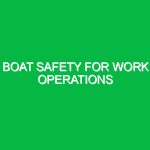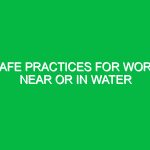Personal flotation devices (PFDs) are crucial safety equipment designed to keep individuals afloat in water. Their usage is not just a recommendation; it’s a necessity that aligns with health, safety, and environmental (HSE) standards. Whether you are an avid boater, a professional in the marine industry, or someone who enjoys swimming, understanding the significance of PFDs is vital. This comprehensive guide will delve into the essential aspects of PFDs, including their relevance in HSE, potential hazards associated with their usage, safety precautions, best practices, and the regulations governing their use.
The Importance of PFDs in HSE
PFDs are designed to provide buoyancy and prevent drowning in various aquatic environments. They come in various forms, including life jackets, vests, and buoyancy aids, each serving specific purposes. In the realm of HSE, the use of PFDs is paramount for several reasons:
- Risk Mitigation: PFDs significantly reduce the risk of drowning, which is a leading cause of accidental death in water-related activities.
- Compliance with Regulations: Many jurisdictions mandate the use of PFDs, making compliance a legal requirement that protects organizations from liability.
- Promotion of Safety Culture: The consistent use of PFDs fosters a culture of safety, encouraging individuals to prioritize their well-being and that of others.
By understanding the importance of PFDs and adhering to HSE guidelines, individuals and organizations can create safer environments for activities involving water.
Potential Hazards and Risks Associated with PFDs Usage
While PFDs are life-saving devices, their effectiveness can be compromised by various hazards and risks. Recognizing these potential issues is essential for ensuring safety during water activities.
1. Improper Fit and Usage
One of the most significant risks associated with PFDs is the improper fit. A PFD that is too loose may come off in the water, while one that is too tight can restrict movement and breathing. According to a study conducted by the U.S. Coast Guard, improper fit is a leading cause of PFD failure during emergencies. Always ensure that the PFD fits snugly but comfortably, allowing for free movement.
2. Inadequate Maintenance
PFDs require regular maintenance to function correctly. Wear and tear, exposure to sun, saltwater, or chemicals can degrade the materials and reduce their effectiveness. A personal anecdote from a sailing instructor highlights this risk: “I always inspect my students’ PFDs before we head out. Last summer, one student’s vest had a tear that was barely visible. Luckily, we caught it in time, but it could have been a dangerous oversight.” Regular inspections and proper storage are vital in preventing such hazards.
3. Environmental Conditions
Environmental factors such as rough waters, extreme temperatures, and weather conditions can affect the performance of PFDs. For instance, colder waters can lead to hypothermia, making it essential to select a PFD designed for specific conditions. Understanding local weather patterns and preparing accordingly can mitigate these risks.
Safety Precautions and Best Practices for PFD Usage
To maximize the effectiveness of PFDs and minimize associated risks, individuals must adhere to specific safety precautions and best practices.
1. Select the Right Type of PFD
Different PFDs serve various purposes. For example, Type I PFDs are designed for offshore use and provide the greatest buoyancy, while Type III PFDs are more comfortable for water sports. Choose a PFD that suits the activity and environment. Always refer to the U.S. Coast Guard classification system for guidance on the appropriate PFD type.
2. Conduct Regular Inspections
Before any water activity, inspect PFDs for signs of damage, wear, or degradation. Look for frays, tears, or broken buckles. A simple checklist can help ensure that all safety equipment is in good condition. Remember, a small oversight can lead to significant consequences.
3. Educate Users on Proper Usage
Education is key to safe PFD usage. Ensure that all users understand how to wear and use PFDs correctly. Conduct drills or training sessions to familiarize participants with the proper techniques. For instance, a local boating club organizes annual safety workshops where experienced sailors teach newcomers the essentials of PFD usage.
4. Emphasize the Importance of Wearing PFDs
Encourage a culture of safety by promoting the consistent wearing of PFDs, even in calm waters. A study by the National Institute for Occupational Safety and Health (NIOSH) found that wearing PFDs at all times significantly reduces the risk of drowning. Make it a habit to wear PFDs during all water activities.
5. Stay Informed About Environmental Conditions
Before heading out, check weather forecasts and water conditions. Sudden changes in weather can create hazardous situations. Knowledge of local conditions can help you make informed decisions about whether to proceed with water-related activities or postpone them for safety.
Regulations and Standards Governing PFD Usage
Adhering to regulations and standards is a fundamental aspect of safe PFD usage. Various authorities govern the use of PFDs, ensuring compliance and safety across different industries.
1. U.S. Coast Guard Regulations
The U.S. Coast Guard mandates that all recreational vessels carry a U.S. Coast Guard-approved PFD for each person aboard. Additionally, certain vessels must also have a throwable PFD on board. It is imperative to keep abreast of these regulations and ensure compliance to avoid penalties and ensure safety.
2. Occupational Safety and Health Administration (OSHA) Standards
In occupational settings, OSHA has established guidelines for the use of PFDs. Employers are required to assess hazards and provide appropriate protective equipment to employees engaged in water-related activities. This includes ensuring that PFDs are available, properly maintained, and fit the users adequately.
3. International Maritime Organization (IMO) Standards
The IMO sets international standards for safety at sea, which include guidelines on the use of PFDs. These standards emphasize the importance of training and education for personnel involved in maritime activities. Adhering to these standards not only enhances safety but also promotes a culture of responsibility among maritime workers.
Conclusion
Personal flotation devices (PFDs) are indispensable tools in promoting safety during water-related activities. Their proper usage can significantly reduce the risk of drowning and enhance overall water safety. By understanding the potential hazards associated with PFDs, adhering to safety precautions, and complying with relevant regulations, individuals and organizations can create a culture of safety that protects everyone involved. Remember, the ocean may be vast, but with the right knowledge and equipment, we can navigate its challenges safely. Prioritize PFD usage and make every water outing a safe and enjoyable experience.


